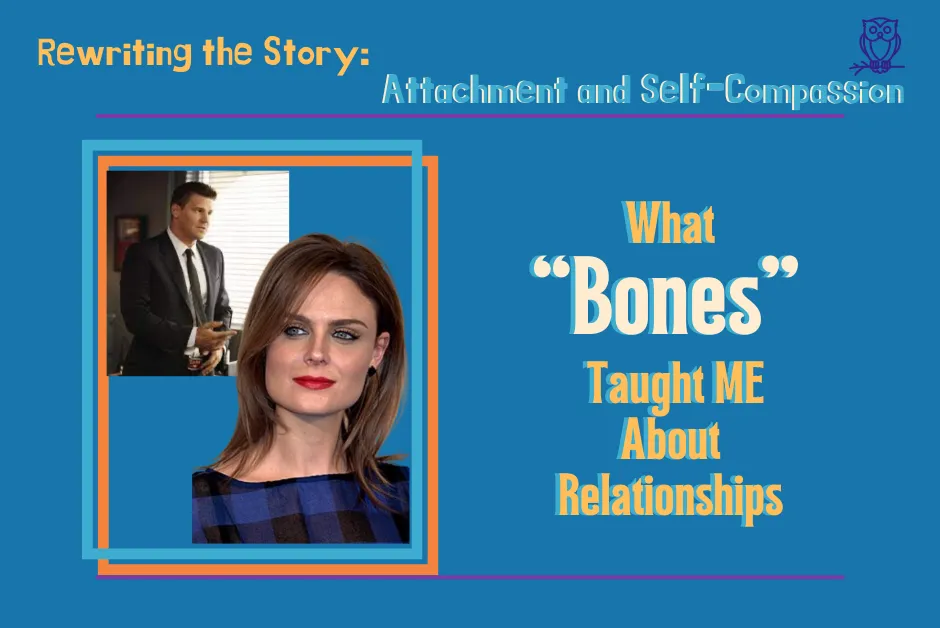
Rewriting the Story: Attachment and Self-Compassion
By the time we reach this stage in the Attachment series, we’ve explored a lot together — pausing before reacting, loosening rigid rules, learning presence, questioning our “shoulds,” practising patience, and understanding that parenting (and life) is a long game.
Last week, we talked about why wisdom takes time — and how experience shapes it.
This week, we turn the lens inward.
Because rewriting the story of attachment begins with self-compassion — and sometimes the insights arrive from the most unexpected places, like the TV screen.
What “Bones” Taught Me About Relationships — and Why One Person Often Carries the Load (for a While)
I’ve always loved watching human behaviour unfold — and sometimes my classroom is the TV.
As someone trained in human development and behaviour, I’ve realised over the years that my favourite shows often give me a window into how people connect, disconnect, and rebuild. As a Human Design 3/5 Generator, I learn best through experience — and TV offers a safe place to observe the emotional and relational patterns that play out in real life.
One of my favourite shows lately is Bones. I’ve just rewatched all 12 seasons, and as I circle back to the early episodes, I’m struck again by how the dynamic between Brennan and Booth demonstrates what it takes for two people with completely different wiring to build something functional — and even beautiful — together.
Opposites Don’t Just Attract — They Evolve Each Other
In the first season, Booth and Brennan could hardly communicate. He leads with instinct and emotional intelligence; she leads with logic and reason. Each speaks a different language, shaped by their temperament, upbringing, and belief systems.
Yet, somehow, it works — not because they’re similar, but because one of them, at any given time, chooses to carry more of the load.
That’s something we often miss when we talk about “healthy relationships.” They aren’t perfectly balanced all the time. In the beginning, especially, one person will need to adjust more — not as a sign of weakness, but as an act of bridge-building.
In Bones, Booth often has to meet Brennan where she is. He learns to be patient with her emotional awkwardness, her intellectual defensiveness, and her inability to read subtle cues. But what’s really happening beneath the surface is a dance — one learning safety through empathy, the other learning empathy through safety.
When You’re the One Who Feels Like You’re Always Adapting
I understand this dynamic intimately.
In my own relationship, without any conscious awareness, I was the one who was less skilled at noticing and adapting in my communication. My hypervigilance — those survival skills I’d developed long before I understood them — meant I could pick up what was happening under the surface but often missed what was happening right in front of me.
I didn’t realise there was a problem. I thought I was being “fine.” But what I’ve learned is that connection doesn’t come from reading people’s intentions; it comes from developing the capacity to meet them where they are — to allow curiosity, not defensiveness, to guide the moment.
That shift doesn’t happen overnight. It’s a process of building internal safety — the kind that lets you stay open long enough to see the person in front of you, not just your own interpretation of them.
Real Relationships Grow from Safety, Not Perfection
A healthy relationship doesn’t start with two people who have it all figured out. It begins when at least one person has the intention to understand the other — not to accept poor treatment, but to model compassion and create the safety for growth.
That’s what Booth and Brennan show us so powerfully. Their partnership becomes functional because one chooses patience while the other learns trust. It’s not easy, but it’s real.
From personal experience, I know this kind of transformation is possible. We can move from patterns of protection and disconnection to awareness, compassion, and genuine collaboration.
But first, we have to realise it’s a journey — one that starts with self-awareness, a willingness to learn, and the understanding that connection is built, not found.
Building Beautiful Foundations
If you’re reading this and recognising yourself as the one who’s always adapting — or perhaps the one who struggles to — I want you to know it’s possible to create relationships that feel safe, supportive, and truly connected.
You don’t have to figure it out alone.
That’s exactly what I help parents and partners do — build the beautiful foundations that make healthy connection possible.
If you’d like to explore how your wiring, communication style, and early attachment experiences shape the way you relate, I invite you to start with a Clarity Session.
Together, we can explore your unique design, your story, and the next small step toward creating the connection you’ve been craving.
👉Book a free Clarity Session and begin your journey toward the relationships you were born to build. Click Here.